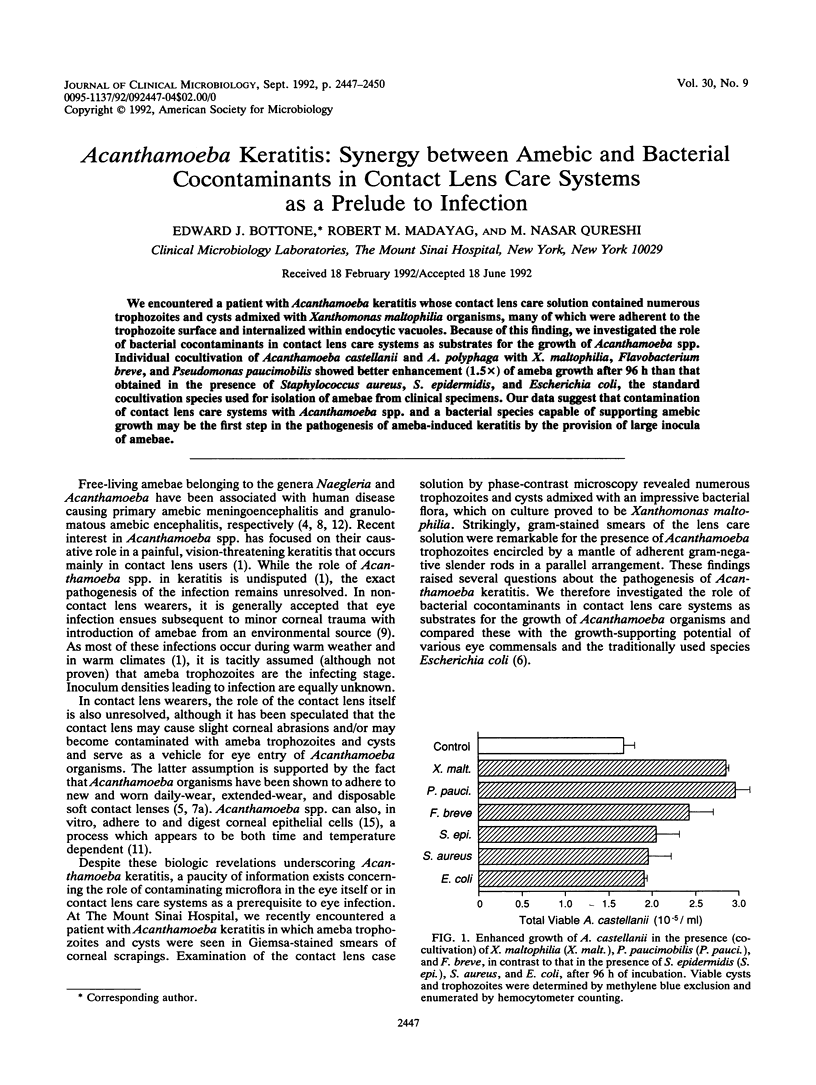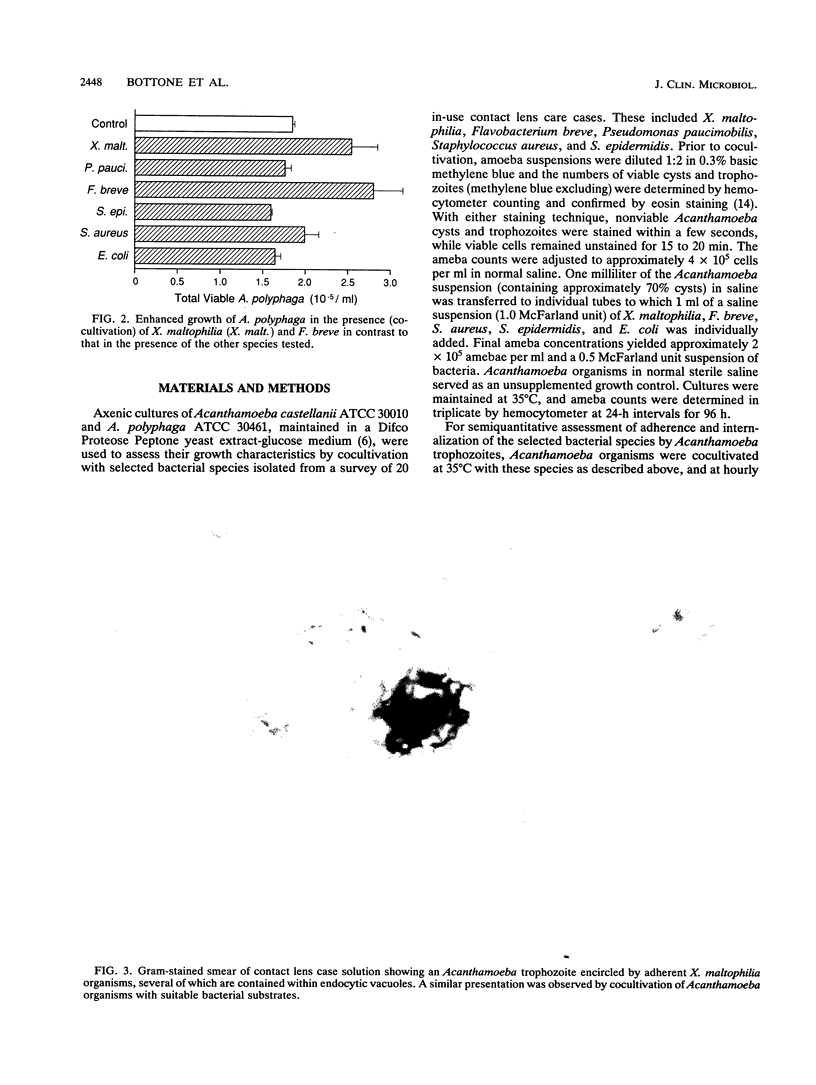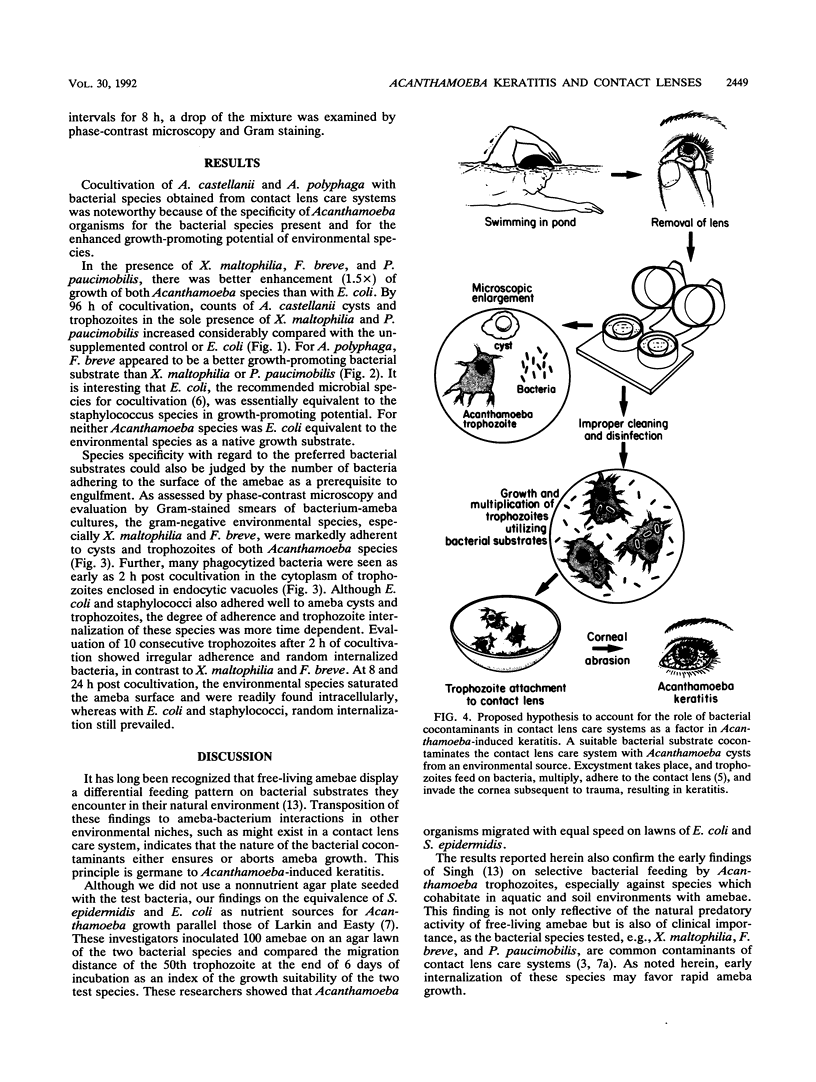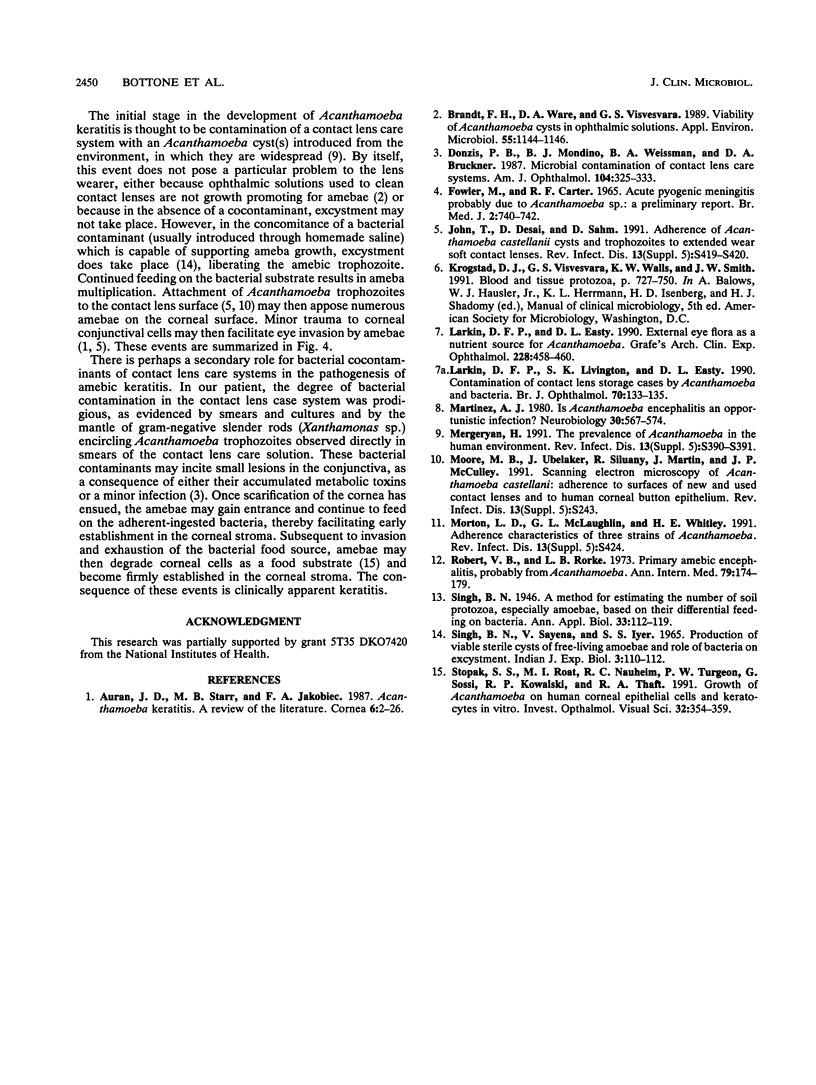Abstract
We encountered a patient with Acanthamoeba keratitis whose contact lens care solution contained numerous trophozoites and cysts admixed with Xanthomonas maltophilia organisms, many of which were adherent to the trophozoite surface and internalized within endocytic vacuoles. Because of this finding, we investigated the role of bacterial cocontaminants in contact lens care systems as substrates for the growth of Acanthamoeba spp. Individual cocultivation of Acanthamoeba castellanii and A. polyphaga with X. maltophilia, Flavobacterium breve, and Pseudomonas paucimobilis showed better enhancement (1.5x) of ameba growth after 96 h than that obtained in the presence of Staphylococcus aureus, S. epidermidis, and Escherichia coli, the standard cocultivation species used for isolation of amebae from clinical specimens. Our data suggest that contamination of contact lens care systems with Acanthamoeba spp. and a bacterial species capable of supporting amebic growth may be the first step in the pathogenesis of ameba-induced keratitis by the provision of large inocula of amebae.
Full text
PDF



Images in this article
Selected References
These references are in PubMed. This may not be the complete list of references from this article.
- Auran J. D., Starr M. B., Jakobiec F. A. Acanthamoeba keratitis. A review of the literature. Cornea. 1987;6(1):2–26. [PubMed] [Google Scholar]
- Brandt F. H., Ware D. A., Visvesvara G. S. Viability of Acanthamoeba cysts in ophthalmic solutions. Appl Environ Microbiol. 1989 May;55(5):1144–1146. doi: 10.1128/aem.55.5.1144-1146.1989. [DOI] [PMC free article] [PubMed] [Google Scholar]
- Donzis P. B., Mondino B. J., Weissman B. A., Bruckner D. A. Microbial contamination of contact lens care systems. Am J Ophthalmol. 1987 Oct 15;104(4):325–333. doi: 10.1016/0002-9394(87)90219-4. [DOI] [PubMed] [Google Scholar]
- Fowler M., Carter R. F. Acute pyogenic meningitis probably due to Acanthamoeba sp.: a preliminary report. Br Med J. 1965 Sep 25;2(5464):740–742. doi: 10.1136/bmj.2.5464.734-a. [DOI] [PMC free article] [PubMed] [Google Scholar]
- John T., Desai D., Sahm D. Adherence of Acanthamoeba castellanii cysts and trophozoites to extended wear soft contact lenses. Rev Infect Dis. 1991 Mar-Apr;13 (Suppl 5):S419–S420. doi: 10.1093/clind/13.supplement_5.s419. [DOI] [PubMed] [Google Scholar]
- Larkin D. F., Easty D. L. External eye flora as a nutrient source for Acanthamoeba. Graefes Arch Clin Exp Ophthalmol. 1990;228(5):458–460. doi: 10.1007/BF00927262. [DOI] [PubMed] [Google Scholar]
- Larkin D. F., Kilvington S., Easty D. L. Contamination of contact lens storage cases by Acanthamoeba and bacteria. Br J Ophthalmol. 1990 Mar;74(3):133–135. doi: 10.1136/bjo.74.3.133. [DOI] [PMC free article] [PubMed] [Google Scholar]
- Martínez A. J. Is Acanthamoeba encephalitis an opportunistic infection? Neurology. 1980 Jun;30(6):567–574. doi: 10.1212/wnl.30.6.567. [DOI] [PubMed] [Google Scholar]
- Mergeryan H. The prevalence of Acanthamoeba in the human environment. Rev Infect Dis. 1991 Mar-Apr;13 (Suppl 5):S390–S391. doi: 10.1093/clind/13.supplement_5.s390. [DOI] [PubMed] [Google Scholar]
- Morton L. D., McLaughlin G. L., Whiteley H. E. Adherence characteristics of three strains of Acanthamoeba. Rev Infect Dis. 1991 Mar-Apr;13 (Suppl 5):S424–S424. doi: 10.1093/clind/13.supplement_5.s424. [DOI] [PubMed] [Google Scholar]
- Robert V. B., Rorke L. B. Primary amebic encephalitis, probably from Acanthamoeba. Ann Intern Med. 1973 Aug;79(2):174–179. doi: 10.7326/0003-4819-79-2-174. [DOI] [PubMed] [Google Scholar]
- SINGH B. N., SAXENA U., IYER S. S. PRODUCTION OF VIABLE STERILE CYSTS OF FREE-LIVING AMOEBAE & ROLE OF BACTERIA ON EXCYSTMENT. Indian J Exp Biol. 1965 Apr;3:110–112. [PubMed] [Google Scholar]
- Stopak S. S., Roat M. I., Nauheim R. C., Turgeon P. W., Sossi G., Kowalski R. P., Thoft R. A. Growth of acanthamoeba on human corneal epithelial cells and keratocytes in vitro. Invest Ophthalmol Vis Sci. 1991 Feb;32(2):354–359. [PubMed] [Google Scholar]



